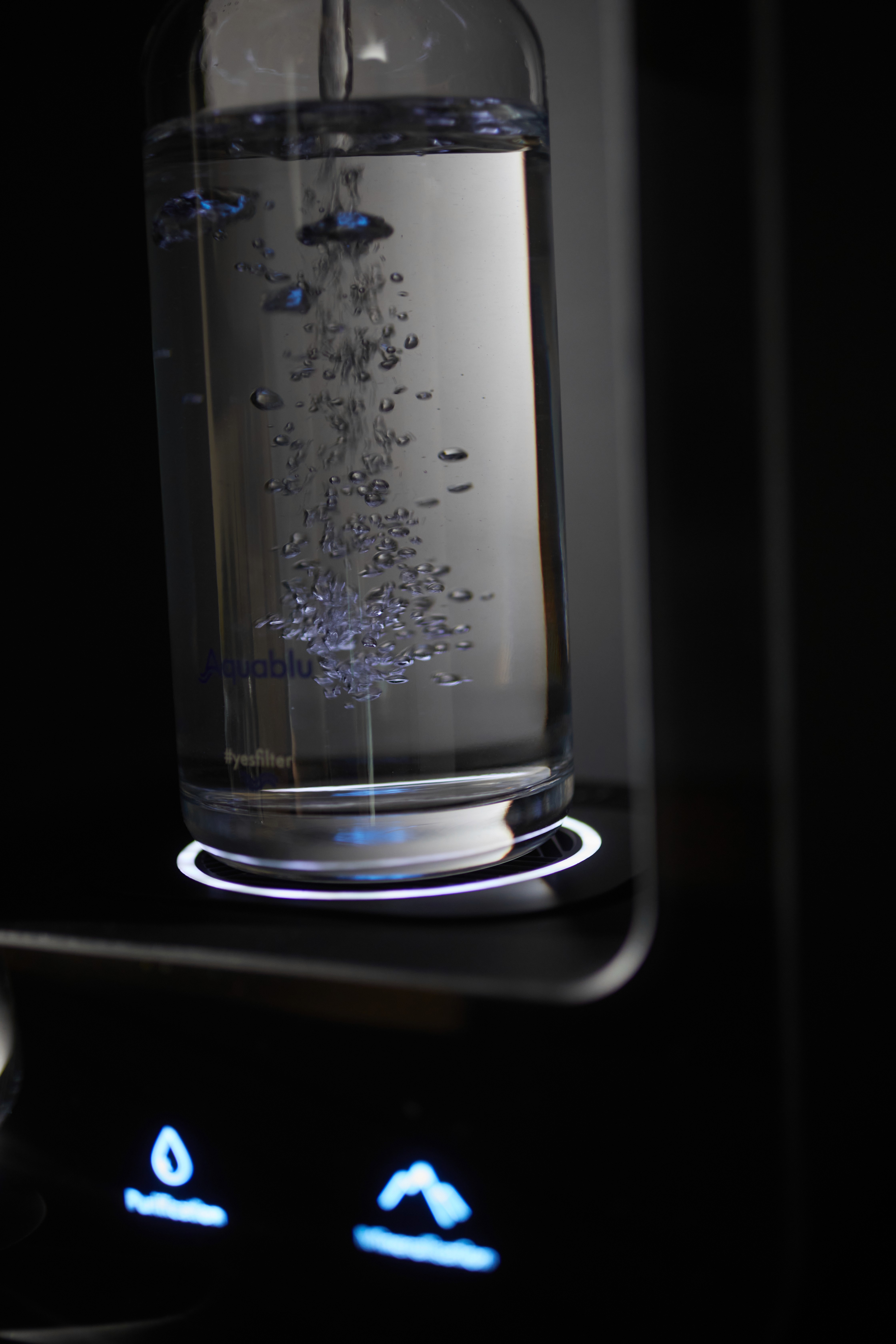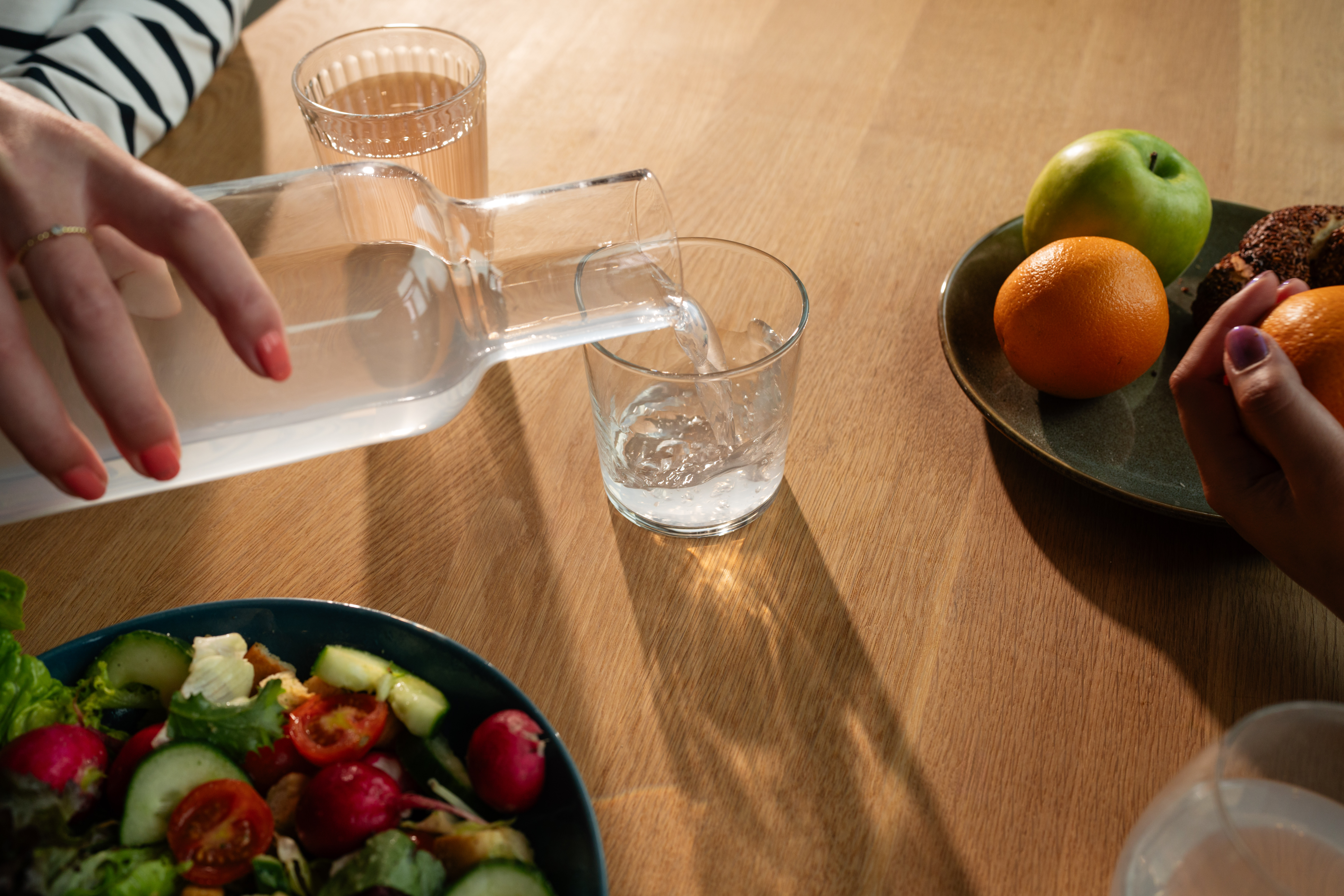FOR OFFICES
OFFICES & WORKSPACES
Smart hydration for modern workspaces
SMART WATER DISPENSER
Reduce cost & Boost productivity
OFFICE MANAGERS
Manage hydration with zero hassle
FOR HOTELS
HOTELS
Elevate your guest experience
Manage beverages with zero hassle
Streamline F&B with Aquablu
Microplastics in water: how to filter them
Microplastics in water: how to filter them
6 min
6 min
6 min
|
|
|
6 min
|



Plastics are taking over. They surround us everywhere we go. You can find plastics in our oceans, in massive landfills or in our drinking water in the form of small plastic particles, also known as microplastics and nanoplastics. Even though the amount of microplastics in the water is not yet harmful for most healthy humans, it is not something we like to have in our drinking water. In this blog, we will discuss how you can filter microplastics from tap water.
WHAT ARE MICROPLASTICS AND NANOPLASTICS?
Microplastics are small plastic particles, usually less than 5mm in size, that have become a major concern for the environment, economy, and human health. These particles are found in many consumer products, including clothing, cosmetics, and cleaning products, and they can end up in our tap water through various sources. It is estimated that in the near future the amount of plastics in our water will only rise, as we use more and more plastics and they end up in our environment more often.
Check this blog first if you want to know more about microplastics before continuing on how to filter microplastics.
Nanoplastics are even smaller particles – 1000 smaller than the diameter of an average human hair. They actually make up around 90% of the plastic particles detected in water. The effects of nanoplastics on human health are still under-researched. However, the research available on microplastics suggests possibilities of disruption of hormone levels and the immune system. For now, all this is more speculation than fact.
Nevertheless, it’s better to be safe than sorry. That’s why we’ve compiled a list of solutions for filtering microplastics from your water.






HOW TO FILTER MICROPLASTICS FROM TAP WATER
There are several steps that you can take to reduce your exposure to these nasty plastic particles. Here are some effective ways to remove microplastics from tap water:
1. Use a water filter
One of the most effective ways to remove microplastics from tap water is to use a water filter. There are many different types of water filters on the market, including activated carbon filters, reverse osmosis filters, and ceramic filters. These filters can help to remove not only microplastics but also other contaminants, such as chlorine, lead, and bacteria.
We offer water dispensers for organisations that filter microplastics from the tapwater with patent-pending technology. The Aquablu REFILL+ filters harmful contaminations and adds important vitamins and minerals in four different healthy natural flavors.
2. Use a filtering water bottle
If you are on the go, a filtering water bottle can be a convenient way to remove microplastics from tap water. These bottles contain a built-in filter that removes impurities, including microplastics, from the water as you drink it. It is important to check the lifespan of your filtering water bottle and how often you can use it. You can find all sorts of water bottles with built-in filters online, check which one fits your needs and filters out the contaminations that you want to be filtered.
Replace the bottle or filters compartments off the bottle often to ensure a safe and healthy water quality without plastics and contaminations.
3. Distill your water
While not the most attainable option, it is one that is one of the most effective. Water distillation is the process of boiling water and collecting the condensation, leaving behind impurities like heavy metals and microplastics. Water distillation systems can be costly, but there are DIY purification methods you can try with regular household items. An easy alternative is simply buying distilled water instead.
4. Reduce plastic use
Alright, this solution is perhaps not the most direct one, but it is definitely the most sustainable one. Reducing your use of plastic products can help to reduce the amount of microplastics that end up in the environment and ultimately in our tap water.
How STARP Ditched Bottles and Cans in the Office and Sparked a Hydration Habit
Try to avoid single-use plastic items, such as non reusable water bottles, straws, and utensils, and instead opt for reusable alternatives made from materials like glass or stainless steel.
Looking for simple ways to reduce your plastic use? Here you can find a list with tips to reduce your plastic usage.
HOW TO FILTER MICROPLASTICS FROM TAP WATER
There are several steps that you can take to reduce your exposure to these nasty plastic particles. Here are some effective ways to remove microplastics from tap water:
1. Use a water filter
One of the most effective ways to remove microplastics from tap water is to use a water filter. There are many different types of water filters on the market, including activated carbon filters, reverse osmosis filters, and ceramic filters. These filters can help to remove not only microplastics but also other contaminants, such as chlorine, lead, and bacteria.
We offer water dispensers for organisations that filter microplastics from the tapwater with patent-pending technology. The Aquablu REFILL+ filters harmful contaminations and adds important vitamins and minerals in four different healthy natural flavors.
2. Use a filtering water bottle
If you are on the go, a filtering water bottle can be a convenient way to remove microplastics from tap water. These bottles contain a built-in filter that removes impurities, including microplastics, from the water as you drink it. It is important to check the lifespan of your filtering water bottle and how often you can use it. You can find all sorts of water bottles with built-in filters online, check which one fits your needs and filters out the contaminations that you want to be filtered.
Replace the bottle or filters compartments off the bottle often to ensure a safe and healthy water quality without plastics and contaminations.
3. Distill your water
While not the most attainable option, it is one that is one of the most effective. Water distillation is the process of boiling water and collecting the condensation, leaving behind impurities like heavy metals and microplastics. Water distillation systems can be costly, but there are DIY purification methods you can try with regular household items. An easy alternative is simply buying distilled water instead.
4. Reduce plastic use
Alright, this solution is perhaps not the most direct one, but it is definitely the most sustainable one. Reducing your use of plastic products can help to reduce the amount of microplastics that end up in the environment and ultimately in our tap water.
How STARP Ditched Bottles and Cans in the Office and Sparked a Hydration Habit
Try to avoid single-use plastic items, such as non reusable water bottles, straws, and utensils, and instead opt for reusable alternatives made from materials like glass or stainless steel.
Looking for simple ways to reduce your plastic use? Here you can find a list with tips to reduce your plastic usage.
HOW TO FILTER MICROPLASTICS FROM TAP WATER
There are several steps that you can take to reduce your exposure to these nasty plastic particles. Here are some effective ways to remove microplastics from tap water:
1. Use a water filter
One of the most effective ways to remove microplastics from tap water is to use a water filter. There are many different types of water filters on the market, including activated carbon filters, reverse osmosis filters, and ceramic filters. These filters can help to remove not only microplastics but also other contaminants, such as chlorine, lead, and bacteria.
We offer water dispensers for organisations that filter microplastics from the tapwater with patent-pending technology. The Aquablu REFILL+ filters harmful contaminations and adds important vitamins and minerals in four different healthy natural flavors.
2. Use a filtering water bottle
If you are on the go, a filtering water bottle can be a convenient way to remove microplastics from tap water. These bottles contain a built-in filter that removes impurities, including microplastics, from the water as you drink it. It is important to check the lifespan of your filtering water bottle and how often you can use it. You can find all sorts of water bottles with built-in filters online, check which one fits your needs and filters out the contaminations that you want to be filtered.
Replace the bottle or filters compartments off the bottle often to ensure a safe and healthy water quality without plastics and contaminations.
3. Distill your water
While not the most attainable option, it is one that is one of the most effective. Water distillation is the process of boiling water and collecting the condensation, leaving behind impurities like heavy metals and microplastics. Water distillation systems can be costly, but there are DIY purification methods you can try with regular household items. An easy alternative is simply buying distilled water instead.
4. Reduce plastic use
Alright, this solution is perhaps not the most direct one, but it is definitely the most sustainable one. Reducing your use of plastic products can help to reduce the amount of microplastics that end up in the environment and ultimately in our tap water.
How STARP Ditched Bottles and Cans in the Office and Sparked a Hydration Habit
Try to avoid single-use plastic items, such as non reusable water bottles, straws, and utensils, and instead opt for reusable alternatives made from materials like glass or stainless steel.
Looking for simple ways to reduce your plastic use? Here you can find a list with tips to reduce your plastic usage.
HOW TO FILTER MICROPLASTICS FROM TAP WATER
There are several steps that you can take to reduce your exposure to these nasty plastic particles. Here are some effective ways to remove microplastics from tap water:
1. Use a water filter
One of the most effective ways to remove microplastics from tap water is to use a water filter. There are many different types of water filters on the market, including activated carbon filters, reverse osmosis filters, and ceramic filters. These filters can help to remove not only microplastics but also other contaminants, such as chlorine, lead, and bacteria.
We offer water dispensers for organisations that filter microplastics from the tapwater with patent-pending technology. The Aquablu REFILL+ filters harmful contaminations and adds important vitamins and minerals in four different healthy natural flavors.
2. Use a filtering water bottle
If you are on the go, a filtering water bottle can be a convenient way to remove microplastics from tap water. These bottles contain a built-in filter that removes impurities, including microplastics, from the water as you drink it. It is important to check the lifespan of your filtering water bottle and how often you can use it. You can find all sorts of water bottles with built-in filters online, check which one fits your needs and filters out the contaminations that you want to be filtered.
Replace the bottle or filters compartments off the bottle often to ensure a safe and healthy water quality without plastics and contaminations.
3. Distill your water
While not the most attainable option, it is one that is one of the most effective. Water distillation is the process of boiling water and collecting the condensation, leaving behind impurities like heavy metals and microplastics. Water distillation systems can be costly, but there are DIY purification methods you can try with regular household items. An easy alternative is simply buying distilled water instead.
4. Reduce plastic use
Alright, this solution is perhaps not the most direct one, but it is definitely the most sustainable one. Reducing your use of plastic products can help to reduce the amount of microplastics that end up in the environment and ultimately in our tap water.
How STARP Ditched Bottles and Cans in the Office and Sparked a Hydration Habit
Try to avoid single-use plastic items, such as non reusable water bottles, straws, and utensils, and instead opt for reusable alternatives made from materials like glass or stainless steel.
Looking for simple ways to reduce your plastic use? Here you can find a list with tips to reduce your plastic usage.
SUBSCRIBE
TO OUR
Don’t miss out—stay ahead of the wave with new flavors and product launches.
NEWSLETTER
SUBSCRIBE
TO OUR
NEWSLETTER
Don’t miss out—stay ahead of the wave with new flavors and product launches.
SUBSCRIBE
TO OUR
NEWSLETTER
Don’t miss out—stay ahead of the wave with new flavors and product launches.
SUBSCRIBE
TO OUR
Don’t miss out—stay ahead of the wave with new flavors and product launches.
NEWSLETTER
SUBSCRIBE
TO OUR
Don’t miss out—stay ahead of the wave with new flavors and product launches.